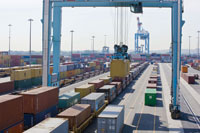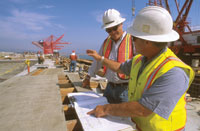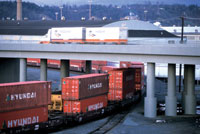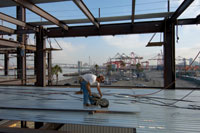 In the United States and around the globe, the volume of goods moving through a nation’s seaports typically reflects the vigor and prosperity of that region or country. When economic conditions decline – as they have in 2009 – the seaport industry is often one of the first to show the effects. And when trade volumes diminish, so do the revenues of thousands of businesses that rely on that trade, and the jobs of millions of workers who depend on the well-being of those businesses.
In the United States and around the globe, the volume of goods moving through a nation’s seaports typically reflects the vigor and prosperity of that region or country. When economic conditions decline – as they have in 2009 – the seaport industry is often one of the first to show the effects. And when trade volumes diminish, so do the revenues of thousands of businesses that rely on that trade, and the jobs of millions of workers who depend on the well-being of those businesses.
In today’s challenging economic environment, diminished consumer demand has caused a great many businesses to cinch up their proverbial belts, reduce expenses, cut staff and diversify their offerings in hopes of riding out the storm. Ports are typically thought to be safe havens in a storm; but in an economic storm such as we are experiencing today, ports too must constantly adapt to meet ever-changing global trade demands. This includes investing in their facilities to enhance their ability to handle cargo more efficiently, and be able to accommodate new cargo.
But even the most productive ports may be hobbled by inefficient cargo transportation networks.
In a manner of speaking, the federal government is missing the boat by short-changing needed investments in intermodal connections with the nation’s seaports. Money spent to improve the cargo connections with our seaports via roads, rails, tunnels, bridges and waterways not only makes ports more efficient and globally competitive, it creates jobs, reduces pollution and congestion, and attracts business.
Why Care About Seaports?
Seaports are where imported goods make their first landfall, and where our nation’s exports to the world first leave our shores. Seaports help us build and grow international trade by strengthening local and national economies. They provide high paying jobs and help increase our standard of living.
In short, they connect us with the rest of the world as the world grows smaller and our mutual dependence on trade becomes more important. This is why keeping seaports modern, navigable, safe and properly supported is such a core priority for the American Association of Port Authorities, and must be for the nation as well.
Seaports Rely on Partnerships Today, as we confront a host of national challenges – chief among them, recovery from our current economic crisis – there is a clear and critical role for our ports. Ports are dynamic, vibrant centers of trade and commerce, but what’s most important to understand is that seaports rely on partnerships.
Today, as we confront a host of national challenges – chief among them, recovery from our current economic crisis – there is a clear and critical role for our ports. Ports are dynamic, vibrant centers of trade and commerce, but what’s most important to understand is that seaports rely on partnerships.
A successful port is supported by clear and navigable waterways – dredged deep enough and wide enough for ships to pass through, and kept clean for the plants, fish and wildlife around it to thrive. A successful port is supported by a national government properly funding the roads, highways, waterways and rail systems around the seaport. And a successful port is one whose government agencies take an active role in the maintenance and upkeep of those systems.
In the U.S., seaports invest more than $2.5 billion annually to maintain and improve their infrastructure. However, in recent years this commitment has not been adequately matched by the federal government.
Many of the land and water connections to America’s seaports are insufficient and outdated, affecting their ability to handle ships and cargo. In turn, this hurts business, hurts workers and hurts the nation’s economy.
Seaports need increased infrastructure investments at the federal level that will correct this imbalance while delivering much needed prosperity to people those ports serve. Underscoring this need are recent estimates that, despite the current downturn, the volume of international trade through our ports will increase significantly by 2020.
Ports rely on partnerships … but partnerships only work if all sides are engaged and invested.
Seaports Are Economic Engines Nearly everything we buy or consume – from the clothes we wear, to the foods we eat, to the coffee we start our day with – comes to us on a ship through one of our seaports. In turn, nearly everything our nation sells in the global marketplace makes its way there via seaports.
Nearly everything we buy or consume – from the clothes we wear, to the foods we eat, to the coffee we start our day with – comes to us on a ship through one of our seaports. In turn, nearly everything our nation sells in the global marketplace makes its way there via seaports.
This includes valuable domestic commodities like grain, coal, steel and building materials.
When you think of seaports, images of cargo containers may come to mind. You might envision huge storage warehouses, or a sea of heavy machinery and industrial equipment. But there’s so much more.
Today’s ports house everything from coffee beans to cruise ship terminals that look more like airport lounges! Cars arriving from overseas are partially assembled there. Produce from South America is treated and inspected there. Huge wind turbine components arrive at our ports, headed for distant wind farms to help produce renewable, domestic energy. Coal and ore from our mines, and grain from our farmland, are loaded onto ships there.
And for every task performed on port sites, for every piece of cargo they process, and for every new capability our ports can offer their customers, there is a jobs impact and an economic impact associated with it.
Consider these numbers:
In 2007 (the most recent year comprehensive numbers are available), U.S. seaports were responsible for more than $3.2 trillion in economic activity – equal to the Gross Domestic Product of Germany. They generated more than $212 billion in tax revenue – enough to pay back more than a quarter of the stimulus funds approved in the American Recovery and Reinvestment Act of 2009. And they handled more than 2 billion tons of cargo – equivalent to over 5 million semi-truck loads!
 Annually, U.S. ports handle more than 99 percent of the country’s overseas cargo, and support about 13.3 million domestic jobs, which accounted for $649 billion in personal income in 2007.
Annually, U.S. ports handle more than 99 percent of the country’s overseas cargo, and support about 13.3 million domestic jobs, which accounted for $649 billion in personal income in 2007.
As broad and as big as their impact is, ports also serve as local economic engines. Just consider the location of the largest U.S. metropolitan centers – such as New York, Los Angeles, Houston, Chicago, Seattle and Miami – and you’ll notice a high percentage have ports that handle ocean-going vessels. Centers of international trade like these are magnets for business and economic development. Consequently, when an economic shot in the arm is needed more than ever, investing in port-related infrastructure is critical.
The Federal Role
With multi-million dollar projects underway at seaports around the country, our port authorities have done a lot to stimulate the economy in recent months – and the transportation infrastructure investments they are making are working. But there’s still more to do.
We must ensure there’s adequate, safe and congestion-free access to our ports from land. So we must ensure there’s modern, navigable waterside access – with channels that are deep enough and wide enough to handle today’s modern vessels, and marine highways to provide transportation options for moving cargo between ports.
These priorities should be included in a long-term, national transportation plan that addresses freight mobility, congestion and productivity. Without such a plan – and the necessary investment to support it – America will be less competitive, consumers will pay higher prices and the economy will suffer.
AAPA believes the federal government should play the appropriate role by helping to enhance the movement of goods to help America regain its competitive footing. Addressing goods movement challenges and alleviating freight congestion must be a top priority in the upcoming surface transportation legislation to help ensure that U.S. farmers, manufacturers and other businesses remain competitive in the global marketplace.
Seaports can play a critical role in our national economic recovery; however, connecting infrastructure to ports requires higher levels of federal investment to createjobs, alleviate congestion and deliver prosperity.
Learning More
To learn more about the value that seaports provide, I encourage you to visit www.seaportsdeliverprosperity.org. Helping advocate for strong, vibrant seaports helps ensure we have a strong, vibrant economy in the months and years ahead.
![]()

